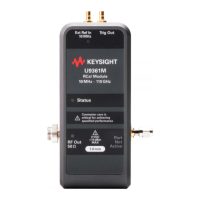U9361C/F/G/M RCal Measurement Guide 11
Getting Started
RCal Software - Configuration
RCal Reference: Selects whether RCal is using its internal 100 MHz clock or
is locked to an external 10 MHz reference. The default (and strongly
recommended) setting is to use an external reference in order to
synchronize the RCal module with the signal analyzer for complex
calibrations.
Identify RCal Module: Identifies the active RCal module. If multiple RCal
modules are connected to the signal analyzer, selecting this key will cause
LEDs on the active unit to flash.
RCal Status: Opens the RCal status and error message dialogue. See
“Errors, Warnings, and Status” on page 18 for more details.
Configuration Table Overview
The RCal configuration table is where you define the measurement parameters
for your RCal correction. The table is initially empty. Select Insert Row below,
or Use Current Meas
1
(located at the top of the configuration window), to start
populating the table.
The simplest and fastest configuration option is to define one single-state
(row). If you anticipate the need to make measurements that involve changing
the analyzer’s state, you can provide ranges within a row or define additional
rows within the same Cal Group. Calibrating for multiple states will require a
longer calibration time, but allows for the RCal to match a wider range of
states.
Rows
A row contains a collection of settings or ranges for RCal operation. A row is
linked to the analyzer’s settings or “state” which can be viewed as an internal
path through the analyzer. The row with a blue border is active for editing. To
change the active editing row, use the button to select the desired row. The
Insert, Duplicate, and Delete buttons operate on the active row.
Columns
The columns contain the state settings or ranges that RCal needs for
calibration. Some column groups allow you to define a range of settings; e.g.
Frequency and Attenuation have Start/Stop/Step parameters. Other columns
contain On/Off settings or provide a drop-down table of options, such as for IF
Path or μW Path Ctrl. If you want to calibrate more than one of these choices,
add another row and select each alternative in separate rows.
1. Use Current Meas automatically populates the Cal Row using parameters from the
current X-Series Signal Analyzer application. This feature is supported by the Signal
Analyzer mode and many others, but it is not supported by every X-Series Signal
Analyzer application.

